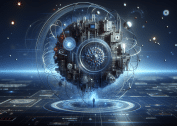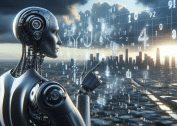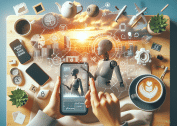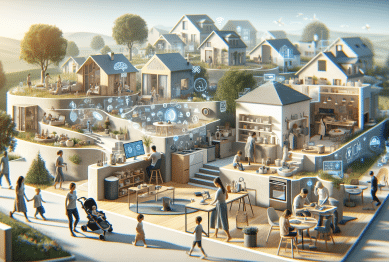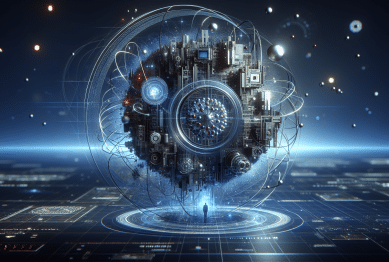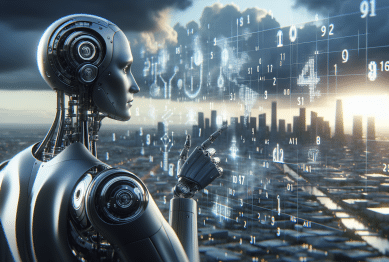Artificial intelligence is transforming the world around you—often in ways you might not notice. This guide explores how AI impacts daily life, from smart homes to advanced healthcare, and answers some of today’s top questions about this fascinating technology.
The Foundations of Artificial Intelligence Explained
Artificial intelligence, often shortened to AI, represents the fascinating field of creating systems that can mimic aspects of human thinking. At the core, AI utilizes algorithms, deep learning, and neural networks to process data and recognize patterns. Unlike regular software, artificial intelligence adapts and changes its responses based on experience, which makes it uniquely powerful for everything from voice assistants to fraud detection. The concepts behind AI aren’t as mysterious as they seem: the foundational layers often begin with collecting large sets of data and teaching the system how to learn from information—much like a student learns best with frequent practice and feedback.
Industrial and academic interest in artificial intelligence surged when simple computer programs began to solve complex problems once reserved for human minds. Today, AI is no longer limited to futuristic theories; it’s coded into many applications people use regularly. An essential foundation for modern AI is machine learning, a branch that enables computers to improve outcomes without explicit programming for every scenario. Machine learning, together with natural language processing, now powers chatbots, recommendation systems, and even the filters that clean up spam emails. AI’s rise has opened new ways for organizations to operate efficiently and has made personalized advice and suggestions more accessible than ever before.
What sets contemporary artificial intelligence apart is the rapid development of deep learning. This subfield uses layered neural networks, similar to how the human brain functions, allowing systems to analyze images, interpret speech, and generate meaningful content. Deep learning’s surge in popularity has expanded the possible applications—from self-driving cars to real-time language translation. As industries invest more in artificial intelligence research, the boundaries of what computers can automate continue to expand, shaping how everything from customer service to decision-making is handled in our interconnected world.
AI Innovations Shaping Your Home and Workplace
Artificial intelligence in everyday life is no longer science fiction. Many households now benefit from AI-powered devices. Smart home assistants, such as voice-activated speakers and learning thermostats, have become commonplace. These systems use speech recognition and machine learning to answer questions, play music, adjust lighting, or optimize heating and cooling based on daily routines. AI also helps with security, monitoring cameras and alerting users to unexpected events. The convenience offered by these innovations shows how seamlessly artificial intelligence integrates with daily routines, making homes safer and more energy-efficient.
Artificial intelligence has a transformative presence in many workplaces, too. Chatbots handle customer inquiries around the clock and learn from prior conversations, steadily improving their responses. Predictive algorithms help companies anticipate supply needs, manage inventory, and streamline logistics, resulting in cost savings and reduced waste. Virtual assistants now schedule meetings, transcribe important information, and summarize documents. Tasks that once required substantial manual labor are partially or fully automated, letting professionals focus on more strategic work. As AI capabilities continue to grow, even industries that once depended largely on hands-on oversight—from manufacturing to education—find themselves relying on intelligent systems.
The journey toward widespread AI adoption isn’t always smooth, but new programs make transitioning easier. For example, AI-driven scheduling tools help coordinate remote teams and track project milestones efficiently. In-home monitoring for older adults is another innovation; systems powered by artificial intelligence can detect unusual behavior patterns or falls, alerting caregivers instantly. Many early adopters have noticed increased comfort, convenience, and even energy savings. AI empowers users to tailor both home and work environments to their unique preferences, allowing more time for creativity or relaxation while still enjoying a high-tech edge.
Artificial Intelligence in Health and Wellness
Healthcare is experiencing an AI revolution. Advanced algorithms analyze vast amounts of health data to assist in detecting illnesses earlier than before. Artificial intelligence often powers diagnostic tools that analyze medical images, searching for abnormalities—like tiny tumors or early signs of disease—that trained professionals might miss. By offering a second layer of review, AI can enhance confidence in clinical decisions. It’s also used in wearable devices that measure vital signs and encourage healthy behaviors; for instance, some fitness trackers provide AI-driven activity recommendations and monitor sleep patterns for personalized guidance.
AI’s role extends into drug discovery and treatment personalization. By examining patterns across millions of patient cases, intelligent platforms help researchers identify promising compounds for clinical trials and predict which therapies could be most effective for specific groups. In predictive medicine, AI models sift through genetics, lifestyle data, and prior health records to flag individuals at risk of chronic conditions such as diabetes or heart disease. As telemedicine expands, chatbots and virtual health assistants assist patients by answering medical questions and helping schedule appointments, which streamlines care and reduces barriers to access.
Artificial intelligence also enhances public health efforts with sophisticated models that monitor and predict outbreaks of infectious diseases. Governments, medical institutions, and NGOs now rely on AI to quickly analyze infection rates, share public updates, and optimize resource allocation more efficiently than ever before. AI’s ability to translate and simplify complex health information allows a wider audience to understand possible risks and prevention strategies, leading to healthier populations overall. With ethical safeguards and rigorous oversight, AI in healthcare stands to make prevention and care more personalized and accessible for millions.
How Artificial Intelligence Drives Discovery in Science
Scientists are pushing the boundaries of knowledge with artificial intelligence. In physics, astronomy, and material science, AI is used to analyze massive data streams that, until recently, would take years for humans to process. For example, telescope arrays searching for distant planets or mapping galaxies now rely on machine learning algorithms to sort through noise and identify meaningful cosmic signals. AI speeds up discoveries by flagging patterns and anomalies, allowing researchers to focus on results that matter most. This accelerates learning and often leads to groundbreaking insights in basic research.
In environmental science and biology, AI reveals subtleties in huge datasets—such as satellite images or gene sequences—that can help address global challenges. By analyzing weather patterns, climate models, or environmental sensor feeds, AI improves forecasting accuracy and aids disaster preparedness. Conservationists use artificial intelligence to monitor endangered species, track poaching risks, and analyze ecosystem health. AI’s precision not only saves time but also enhances quick, responsive approaches to pressing scientific questions that impact society and the planet.
Artificial intelligence also underpins advances in chemistry, genomics, and even quantum computing. AI optimizes chemical reactions for new materials and fuels, predicts protein folding in medical research, and manages the overwhelming complexity of quantum data. The next breakthroughs in medicine, energy, and climate solutions will likely be discovered faster thanks to these intelligent systems. As a knowledge accelerator, AI bridges gaps across scientific disciplines, expanding our collective understanding and opening doors to further exploration of the universe’s hidden mysteries.
Addressing the Ethics and Challenges of AI Progress
Widespread use of artificial intelligence brings important questions about ethics and responsibility. As AI systems become more involved in decision-making, equitable outcomes and transparency are crucial. Some challenges include algorithmic bias—where systems unintentionally reflect or amplify societal prejudices—and issues of privacy when sensitive data is analyzed. Organizations and researchers have responded with robust guidelines: ethical frameworks, oversight committees, and ongoing evaluation of AI’s societal impact aim to ensure fairness and accountability.
Privacy protection is a central concern in the age of AI. Many platforms use advanced encryption and anonymization techniques to safeguard user data, but questions remain about consent and data sharing. Consumers benefit from understanding the privacy practices of their devices, especially those integrated into homes and healthcare settings. Governments and advocacy groups continually update legal standards to address new threats and foster trust in AI-powered products, driving improvements in how personal information is handled and stored.
Another significant ethical focus is ensuring explainability. As artificial intelligence models become more complex, it’s vital that decisions can be interpreted and traced. Research bodies have prioritized explainable AI—the principle that systems should make choices users and professionals can understand. This transparency builds confidence and supports effective decision-making. With clear ethical guardrails, artificial intelligence has the potential to drive progress while maintaining respect for individual rights and social responsibility.
The Future of Artificial Intelligence and What to Expect
The conversation around artificial intelligence is filled with excitement and curiosity about what comes next. Some anticipated advances include more natural, human-like interactions, smarter problem-solving capabilities, and expanded creativity from AI-powered systems. From composing music to inventing new materials, the coming years may see AI evolving beyond support roles to being co-creators with people. Industry leaders and academics expect collaboration between humans and AI will foster entirely new approaches in work, learning, and play—all supported by sophisticated but user-friendly technology.
AI’s integration with robotics and the Internet of Things (IoT) promises seamless, context-aware services that respond to behavior and needs. In cities, AI is being piloted to optimize energy grids, traffic flow, and emergency response coordination. The rise of adaptive learning tools and personalized education points toward better access for students worldwide, adjusting to individual learning speeds and interests. While some predict new kinds of jobs emerging thanks to AI, a commitment to ongoing education and digital literacy ensures people are well-prepared for tomorrow’s opportunities and challenges.
As artificial intelligence technology matures, open dialogue and responsible stewardship remain crucial. The future will depend not only on technical innovation but on thoughtful governance, inclusive design, and a commitment to sharing AI’s benefits widely. Proactive engagement by the public, researchers, and policymakers will shape AI’s positive role, making it a tool for solving global challenges while enhancing daily living.
References
1. National Institute of Standards and Technology. (n.d.). Artificial Intelligence. Retrieved from https://www.nist.gov/artificial-intelligence
2. Pew Research Center. (n.d.). Artificial Intelligence and the Future of Humans. Retrieved from https://www.pewresearch.org/internet/2018/12/10/artificial-intelligence-and-the-future-of-humans/
3. U.S. Food & Drug Administration. (n.d.). Artificial Intelligence and Machine Learning in Software as a Medical Device. Retrieved from https://www.fda.gov/medical-devices/software-medical-device-samd/artificial-intelligence-and-machine-learning-software-medical-device
4. World Health Organization. (n.d.). Ethics and Governance of Artificial Intelligence for Health. Retrieved from https://www.who.int/publications/i/item/9789240029200
5. European Commission. (n.d.). Artificial Intelligence (AI). Retrieved from https://digital-strategy.ec.europa.eu/en/policies/artificial-intelligence
6. Massachusetts Institute of Technology. (n.d.). The MIT Quest for Intelligence. Retrieved from https://quest.mit.edu/



